
- We will send in 10–14 business days.
- Author: Michael Betancourt
- Publisher: Routledge
- ISBN-10: 1138572624
- ISBN-13: 9781138572621
- Format: 14 x 21.6 x 1.1 cm, kieti viršeliai
- Language: English
- SAVE -10% with code: EXTRA
Reviews
Description
In his third book on the semiotics of title sequences, Title Sequences as Paratexts, theorist Michael Betancourt offers an analysis of the relationship between the title sequence and its primary text--the narrative whose production the titles credit. Using a wealth of examples drawn from across film history--ranging from White Zombie (1931), Citizen Kane (1940) and Bullitt (1968) to Prince of Darkness (1987), Mission: Impossible (1996), Sucker Punch (2011) and Guardians of the Galaxy, Vol. 2 (2017)--Betancourt develops an understanding of how the audience interprets title sequences as instances of paranarrative, simultaneously engaging them as both narrative exposition and as credits for the production. This theory of cinematic paratexts, while focused on the title sequence, has application to trailers, commercials, and other media as well.
EXTRA 10 % discount with code: EXTRA
The promotion ends in 23d.11:29:03
The discount code is valid when purchasing from 10 €. Discounts do not stack.
- Author: Michael Betancourt
- Publisher: Routledge
- ISBN-10: 1138572624
- ISBN-13: 9781138572621
- Format: 14 x 21.6 x 1.1 cm, kieti viršeliai
- Language: English English
In his third book on the semiotics of title sequences, Title Sequences as Paratexts, theorist Michael Betancourt offers an analysis of the relationship between the title sequence and its primary text--the narrative whose production the titles credit. Using a wealth of examples drawn from across film history--ranging from White Zombie (1931), Citizen Kane (1940) and Bullitt (1968) to Prince of Darkness (1987), Mission: Impossible (1996), Sucker Punch (2011) and Guardians of the Galaxy, Vol. 2 (2017)--Betancourt develops an understanding of how the audience interprets title sequences as instances of paranarrative, simultaneously engaging them as both narrative exposition and as credits for the production. This theory of cinematic paratexts, while focused on the title sequence, has application to trailers, commercials, and other media as well.


Reviews